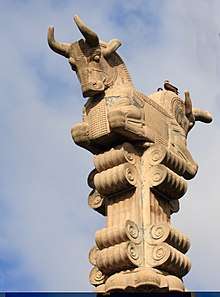Susa
Susa (/ˈsuːsə/; Sumero-Akkadian cuneiform: 𒈹𒂞𒆠 šušinki; Persian: Šuš; [ʃuʃ]; Hebrew: שׁוּשָׁן Šušān; Greek: Σοῦσα [ˈsuːsa]; Syriac: ܫܘܫ Šuš,;[1] Middle Persian: 𐭮𐭥𐭱𐭩 Sūš, 𐭱𐭥𐭮 Šūs; Old Persian: 𐏂𐏁 Çūšā) was an ancient city in the lower Zagros Mountains about 250 km (160 mi) east of the Tigris River, between the Karkheh and Dez Rivers. One of the most important cities of the Ancient Near East, Susa served as the capital of Elam and the Achaemenid Empire, and remained a strategic centre during the Parthian and Sasanian periods.
شوش | |
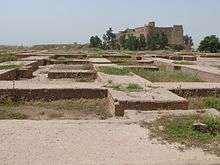 The Palace of Darius I in Susa | |
 Shown within Iran  Susa (West and Central Asia) | |
| Location | Shush, Khuzestan Province, Iran |
|---|---|
| Region | Zagros Mountains |
| Coordinates | 32°11′26″N 48°15′28″E |
| Type | Settlement |
| History | |
| Founded | Approximately 4200 BCE |
| Abandoned | 1218 CE |
| Events | Battle of Susa |
| Site notes | |
| Condition | Abandoned and in ruins |
| Official name | Susa |
| Criteria | Cultural: i, ii, iii, iv |
| Reference | 1455 |
| Inscription | 2015 (39th session) |
The site currently consists of three archaeological mounds, covering an area of around one square kilometre.[2] The modern Iranian town of Shush is located on the site of ancient Susa. Shush is identified as Shushan, mentioned in the Book of Esther and other Biblical books.
Name
In Elamite, the name of the city was written variously Ŝuŝan, Ŝuŝun, etc. The origin of the word Susa is from the local city deity Inshushinak.
Literary references
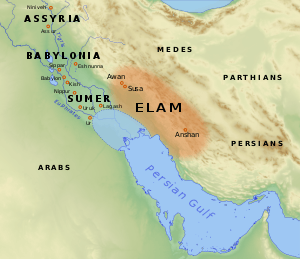
Susa was one of the most important cities of the Ancient Near East. In historic literature, Susa appears in the very earliest Sumerian records: for example, it is described as one of the places obedient to Inanna, patron deity of Uruk, in Enmerkar and the Lord of Aratta.
Biblical texts
Susa is also mentioned in the Ketuvim of the Hebrew Bible by the name Shushan, mainly in Esther, but also once each in Nehemiah and Daniel. According to these texts, Nehemiah also lived in Susa during the Babylonian captivity of the 6th century BCE (Daniel mentions it in a prophetic vision), while Esther became queen there, married to King Ahasuerus, and saved the Jews from genocide. A tomb presumed to be that of Daniel is located in the area, known as Shush-Daniel. However, a large portion of the current structure is actually a much later construction dated to the late nineteenth century, ca. 1871.[3] Susa is further mentioned in the Book of Jubilees (8:21 & 9:2) as one of the places within the inheritance of Shem and his eldest son Elam; and in 8:1, "Susan" is also named as the son (or daughter, in some translations) of Elam.
Excavation history
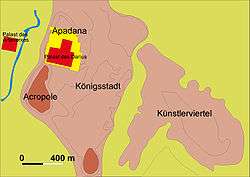
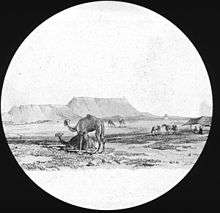
The site was examined in 1836 by Henry Rawlinson and then by A. H. Layard.[4]
In 1851, some modest excavation was done by William Loftus, who identified it as Susa.[5]
In 1885 and 1886 Marcel-Auguste Dieulafoy and Jane Dieulafoy began the first French excavations.[6] Almost all of the excavations at Susa, post 1885, were organized and authorized by the French Monarchy.[7]
Jacques de Morgan conducted major excavations from 1897 until 1911. The excavations that were conducted in Susa brought many artistic and historical artifacts back to France. These artifacts filled multiple halls in the Museum of the Louvre throughout the late 1890s and early 1900s.[8] These efforts continued under Roland De Mecquenem until 1914, at the beginning of World War I. French work at Susa resumed after the war, led by De Mecquenem, continuing until World War II in 1940.[9][10][11] To supplement the original publications of De Mecquenem the archives of his excavation have now been put online thanks to a grant from the Shelby White Levy Program.[12][13]
Roman Ghirshman took over direction of the French efforts in 1946, after the end of the war. Together with his wife Tania Ghirshman, he continued there until 1967. The Ghirshmans concentrated on excavating a single part of the site, the hectare sized Ville Royale, taking it all the way down to bare earth.[14] The pottery found at the various levels enabled a stratigraphy to be developed for Susa.[15][16]
During the 1970s, excavations resumed under Jean Perrot.[17][18]
History
Early settlement
In urban history, Susa is one of the oldest-known settlements of the region. Based on C14 dating, the foundation of a settlement there occurred as early as 4395 BCE (a calibrated radio-carbon date).[19] At this stage it was already very large for the time, about 15 hectares.
The founding of Susa corresponded with the abandonment of nearby villages. Potts suggests that the settlement may have been founded to try to reestablish the previously destroyed settlement at Chogha Mish.[20] Previously, Chogha Mish was also a very large settlement, and it featured a similar massive platform that was later built at Susa.
Another important settlement in the area is Chogha Bonut, that was discovered in 1976.
Susa I period (4200-3800 BCE)
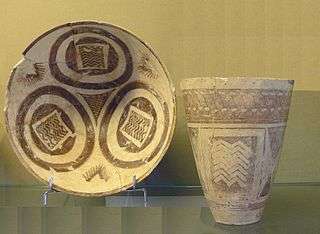
Shortly after Susa was first settled over 6000 years ago, its inhabitants erected a monumental platform that rose over the flat surrounding landscape.[21] The exceptional nature of the site is still recognizable today in the artistry of the ceramic vessels that were placed as offerings in a thousand or more graves near the base of the temple platform.
Susa's earliest settlement is known as Susa I period (c. 4200–3900 BCE). Two settlements named by archaeologists Acropolis (7 ha) and Apadana (6.3 ha), would later merge to form Susa proper (18 ha).[20] The Apadana was enclosed by 6m thick walls of rammed earth (this particular place is named Apadana because it also contains a late Achaemenid structure of this type).
Nearly two thousand pots of Susa I style were recovered from the cemetery, most of them now in the Louvre. The vessels found are eloquent testimony to the artistic and technical achievements of their makers, and they hold clues about the organization of the society that commissioned them.[22] Painted ceramic vessels from Susa in the earliest first style are a late, regional version of the Mesopotamian Ubaid ceramic tradition that spread across the Near East during the fifth millennium BC.[22] Susa I style was very much a product of the past and of influences from contemporary ceramic industries in the mountains of western Iran. The recurrence in close association of vessels of three types—a drinking goblet or beaker, a serving dish, and a small jar—implies the consumption of three types of food, apparently thought to be as necessary for life in the afterworld as it is in this one. Ceramics of these shapes, which were painted, constitute a large proportion of the vessels from the cemetery. Others are coarse cooking-type jars and bowls with simple bands painted on them and were probably the grave goods of the sites of humbler citizens as well as adolescents and, perhaps, children.[23] The pottery is carefully made by hand. Although a slow wheel may have been employed, the asymmetry of the vessels and the irregularity of the drawing of encircling lines and bands indicate that most of the work was done freehand.
Copper metallurgy is also attested during this period, which was contemporary with metalwork at some highland Iranian sites such as Tepe Sialk.

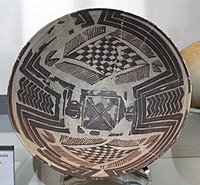
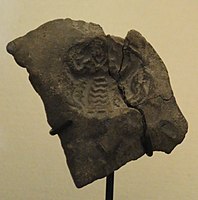 Master of animals, Susa I, Louvre Sb 2246.[24]
Master of animals, Susa I, Louvre Sb 2246.[24] Sun and deities, Susa I, Louvre
Sun and deities, Susa I, Louvre
Susa II and Uruk influence (3800-3100 BCE)
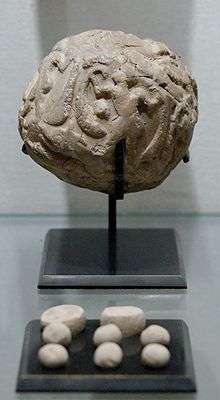
Susa came within the Uruk cultural sphere during the Uruk period. An imitation of the entire state apparatus of Uruk, proto-writing, cylinder seals with Sumerian motifs, and monumental architecture is found at Susa. According to some scholars, Susa may have been a colony of Uruk.
There is some dispute about the comparative periodization of Susa and Uruk at this time, as well as about the extent of Uruk influence in Susa. Recent research indicates that Early Uruk period corresponds to Susa II period.[25]
D. T. Potts, argue that the influence from the highland Iranian Khuzestan area in Susa was more significant at the early period, and also continued later on. Thus, Susa combined the influence of two cultures, from the highland area and from the alluvial plains. Also, Potts stresses the fact that the writing and numerical systems of Uruk were not simply borrowed in Susa wholesale. Rather, only partial and selective borrowing took place, that was adapted to Susa's needs. Despite the fact that Uruk was far larger than Susa at the time, Susa was not its colony, but still maintained some independence for a long time, according to Potts.[30] An architectural link has also been suggested between Susa, Tal-i Malyan, and Godin Tepe at this time, in support of the idea of the parallel development of the protocuneiform and protoelamite scripts.[31]
Some scholars believe that Susa was part of the greater Uruk culture. Holly Pittman, an art historian at the University of Pennsylvania in Philadelphia says, "they [Susanians] are participating entirely in an Uruk way of life. They are not culturally distinct; the material culture of Susa is a regional variation of that on the Mesopotamian plain". Gilbert Stein, director of the University of Chicago's Oriental Institute, says that "An expansion once thought to have lasted less than 200 years now apparently went on for 700 years. It is hard to think of any colonial system lasting that long. The spread of Uruk material is not evidence of Uruk domination; it could be local choice".[32]
Susa III, or "Proto-Elamite", period (3100–2700 BCE)
Susa III (3100–2700 BCE) is also known as the 'Proto-Elamite' period.[37] At this time, Banesh period pottery is predominant. This is also when the Proto-Elamite tablets first appear in the record. Subsequently, Susa became the centre of Elam civilization.
Ambiguous reference to Elam (Cuneiform; 𒉏 NIM) appear also in this period in Sumerian records. Susa enters history during the Early Dynastic period of Sumer. A battle between Kish and Susa is recorded in 2700 BCE, when En-me-barage-si is said to have "made the land of Elam submit".[38]
 Susa III/ Proto-Elamite cylinder seal, 3150–2800 BC. Louvre Museum, reference Sb 1484
Susa III/ Proto-Elamite cylinder seal, 3150–2800 BC. Louvre Museum, reference Sb 1484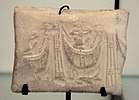 Susa III/ Proto-Elamite cylinder seal 3150–2800 BC Mythological being on a boat Louvre Museum Sb 6379
Susa III/ Proto-Elamite cylinder seal 3150–2800 BC Mythological being on a boat Louvre Museum Sb 6379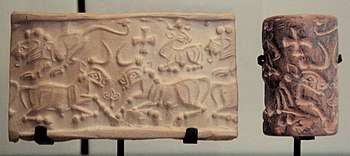 Susa III/ Proto-Elamite cylinder seal 3150–2800 BC Louvre Museum Sb 6166
Susa III/ Proto-Elamite cylinder seal 3150–2800 BC Louvre Museum Sb 6166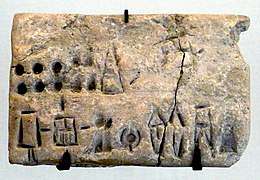 Economical tablet in Proto-Elamite script, Suse III, Louvre Museum, reference Sb 15200, circa 3100-2850 BCE
Economical tablet in Proto-Elamite script, Suse III, Louvre Museum, reference Sb 15200, circa 3100-2850 BCE
Elamites
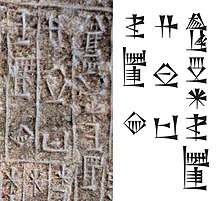
In the Sumerian period, Susa was the capital of a state called Susiana (Šušan), which occupied approximately the same territory of modern Khūzestān Province centered on the Karun River. Control of Susiana shifted between Elam, Sumer, and Akkad. Susiana is sometimes mistaken as synonymous with Elam but, according to F. Vallat, it was a distinct cultural and political entity.[40]
During the Elamite monarch, many riches and materials were brought to Susa from the plundering of other cities.[41] This was mainly due to the fact of Susa's location on Iran's South Eastern region, closer to the city of Babylon and cities in Mesopotamia.
The use of the Elamite language as an administrative language was first attested in texts of ancient Ansan, Tall-e Mal-yan, dated 1000 BCE.[42] Previous to the era of Elamites, the Akkadian language was responsible for most or all of the text used in ancient documents. Susiana was incorporated by Sargon the Great into his Akkadian Empire in approximately 2330 BCE.
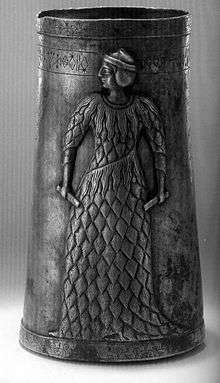
The main goddess of the city was Nanaya, who had a significant temple in Susa.[43]
Old Elamite period (c. 2700–1500 BCE)
The Old Elamite period began around 2700 BCE. Historical records mention the conquest of Elam by Enmebaragesi, the Sumerian king of Kish in Mesopotamia. Three dynasties ruled during this period. Twelve kings of each of the first two dynasties, those of Awan (or Avan; c. 2400–2100 BCE) and Simashki (c. 2100–1970 BC), are known from a list from Susa dating to the Old Babylonian period. Two Elamite dynasties said to have exercised brief control over parts of Sumer in very early times include Awan and Hamazi; and likewise, several of the stronger Sumerian rulers, such as Eannatum of Lagash and Lugal-anne-mundu of Adab, are recorded as temporarily dominating Elam.
Kutik-Inshushinak
Susa was the capital of an Akkadian province until ca. 2100 BCE, when its governor, Kutik-Inshushinak, rebelled and made it an independent state and a literary center. Also, he was the last from the Awan dynasty according to the Susa kinglist.[46] He unified the neighbouring territories and became the king of Elam. He encouraged the use of the Linear Elamite script, that remains undeciphered.
The city was subsequently conquered by the neo-Sumerian Third Dynasty of Ur and held until Ur finally collapsed at the hands of the Elamites under Kindattu in ca. 2004 BCE. At this time, Susa became an Elamite capital under the Epartid dynasty.
Indus-Susa relations (2600-1700 BCE)
Numerous artifact of Indus Valley Civilization origin have been found in Susa from this period, especially seals and etched carnelian beads, pointing to Indus-Mesopotamia relations during this period.[47][48]
 Impression of an Indus cylinder seal discovered in Susa, in strata dated to 2600-1700 BCE. Elongated buffalo with line of standard Indus script signs. Tell of the Susa acropolis. Louvre Museum, reference Sb 2425.[49][50] Indus script numbering convention per Asko Parpola.[51][52]
Impression of an Indus cylinder seal discovered in Susa, in strata dated to 2600-1700 BCE. Elongated buffalo with line of standard Indus script signs. Tell of the Susa acropolis. Louvre Museum, reference Sb 2425.[49][50] Indus script numbering convention per Asko Parpola.[51][52] Indus round seal with impression. Elongated buffalo with Harappan script imported to Susa in 2600-1700 BCE. Found in the tell of the Susa acropolis. Louvre Museum, reference Sb 5614[53]
Indus round seal with impression. Elongated buffalo with Harappan script imported to Susa in 2600-1700 BCE. Found in the tell of the Susa acropolis. Louvre Museum, reference Sb 5614[53]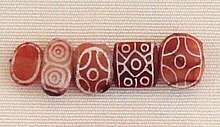 Indian carnelian beads with white design, etched in white with an alkali through a heat process, imported to Susa in 2600-1700 BCE. Found in the tell of the Susa acropolis. Louvre Museum, reference Sb 17751.[54][55][56] These beads are identical with beads found in the Indus Civilization site of Dholavira.[57]
Indian carnelian beads with white design, etched in white with an alkali through a heat process, imported to Susa in 2600-1700 BCE. Found in the tell of the Susa acropolis. Louvre Museum, reference Sb 17751.[54][55][56] These beads are identical with beads found in the Indus Civilization site of Dholavira.[57]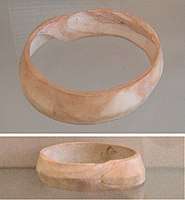 Indus bracelet, front and back, made of Fasciolaria Trapezium or Xandus Pyrum imported to Susa in 2600-1700 BCE. Found in the tell of the Susa acropolis. Louvre Museum, reference Sb 14473.[58] This type of bracelet was manufactured in Mohenjo-daro, Lothal and Balakot.[59] The back is engraved with an oblong chevron design which is typical of shell bangles of the Indus Civilization.[60]
Indus bracelet, front and back, made of Fasciolaria Trapezium or Xandus Pyrum imported to Susa in 2600-1700 BCE. Found in the tell of the Susa acropolis. Louvre Museum, reference Sb 14473.[58] This type of bracelet was manufactured in Mohenjo-daro, Lothal and Balakot.[59] The back is engraved with an oblong chevron design which is typical of shell bangles of the Indus Civilization.[60]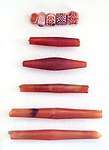 Indus Valley Civilization carnelian beads excavated in Susa.
Indus Valley Civilization carnelian beads excavated in Susa.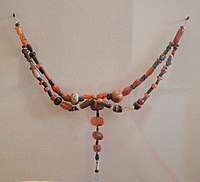 Jewelry with components from the Indus, Central Asia and Northern-eastern Iran found in Susa dated to 2600-1700 BCE.
Jewelry with components from the Indus, Central Asia and Northern-eastern Iran found in Susa dated to 2600-1700 BCE.
Middle Elamite period (c. 1500–1100 BCE)

Around 1500 BCE, the Middle Elamite period began with the rise of the Anshanite dynasties. Their rule was characterized by an "Elamisation" of Susa, and the kings took the title "king of Anshan and Susa". While, previously, the Akkadian language was frequently used in inscriptions, the succeeding kings, such as the Igihalkid dynasty of c. 1400 BCE, tried to use Elamite. Thus, Elamite language and culture grew in importance in Susiana.[40]
This was also the period when the Elamite pantheon was being imposed in Susiana. This policy reached its height with the construction of the political and religious complex at Chogha Zanbil, 30 km (19 mi) south-east of Susa.
In ca. 1175 BCE, the Elamites under Shutruk-Nahhunte plundered the original stele bearing the Code of Hammurabi and took it to Susa. Archeologists found it in 1901. Nebuchadnezzar I of the Babylonian empire plundered Susa around fifty years later.
 An ornate design on this limestone ritual vat from the Middle Elamite period depicts creatures with the heads of goats and the tails of fish, Susa, 1500–1110 BCE.
An ornate design on this limestone ritual vat from the Middle Elamite period depicts creatures with the heads of goats and the tails of fish, Susa, 1500–1110 BCE. The Ziggurat at Chogha Zanbil was built by Elamite king Untash-Napirisha circa 1300 BCE.
The Ziggurat at Chogha Zanbil was built by Elamite king Untash-Napirisha circa 1300 BCE. Susa, Middle-Elamite model of a sun ritual, circa 1150 BCE
Susa, Middle-Elamite model of a sun ritual, circa 1150 BCE
Neo-Elamite period (c. 1100 – 540 BCE)
Neo-Assyrians
In 647 BCE, Neo-Assyrian king Ashurbanipal leveled the city during a war in which the people of Susa participated on the other side. A tablet unearthed in 1854 by Austen Henry Layard in Nineveh reveals Ashurbanipal as an "avenger", seeking retribution for the humiliations that the Elamites had inflicted on the Mesopotamians over the centuries:
"Susa, the great holy city, abode of their gods, seat of their mysteries, I conquered. I entered its palaces, I opened their treasuries where silver and gold, goods and wealth were amassed. . . .I destroyed the ziggurat of Susa. I smashed its shining copper horns. I reduced the temples of Elam to naught; their gods and goddesses I scattered to the winds. The tombs of their ancient and recent kings I devastated, I exposed to the sun, and I carried away their bones toward the land of Ashur. I devastated the provinces of Elam and, on their lands, I sowed salt."[61]
Assyrian rule of Susa began in 647 BCE and lasted till Median capture of Susa in 617 BCE.
Susa after Achaemenid Persian Conquest
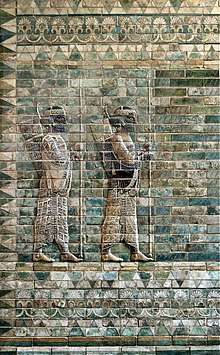

Susa underwent a major political and ethnocultural transition when it became part of the Persian Achaemenid empire between 540 and 539 BCE when it was captured by Cyrus the Great during his conquest of Elam (Susiana), of which Susa was the capital.[62] The Nabonidus Chronicle records that, prior to the battle(s), Nabonidus had ordered cult statues from outlying Babylonian cities to be brought into the capital, suggesting that the conflict over Susa had begun possibly in the winter of 540 BCE.[63]
It is probable that Cyrus negotiated with the Babylonian generals to obtain a compromise on their part and therefore avoid an armed confrontation.[64] Nabonidus was staying in the city at the time and soon fled to the capital, Babylon, which he had not visited in years.[65] Cyrus' conquest of Susa and the rest of Babylonia commenced a fundamental shift, bringing Susa under Persian control for the first time.
Under Cyrus' son Cambyses II, Susa became a center of political power as one of 4 capitals of the Achaemenid Persian empire, while reducing the significance of Pasargadae as the capital of Persis. Following Cambyses' brief rule, Darius the Great began a major building program in Susa and Persepolis,which included building a large palace. During this time he describes his new capital in the DSf inscription:
"This palace which I built at Susa, from afar its ornamentation was brought. Downward the earth was dug, until I reached rock in the earth. When the excavation had been made, then rubble was packed down, some 40 cubits in depth, another part 20 cubits in depth. On that rubble the palace was constructed."[66] Susa continued as a winter capital and residence for Achaemenid kings succeeding Darius the Great, Xerxes I, and their successors.[67]
The city forms the setting of The Persians (472 BCE), an Athenian tragedy by the ancient Greek playwright Aeschylus that is the oldest surviving play in the history of theatre.
Events mentioned in the Old Testament book of Esther are said to have occurred in Susa during the Achaemenid period.
Seleucid period
.jpg)
Susa lost much of its importance after the invasion of Alexander the Great of Macedon in 331 BCE. In 324 BCE he met Nearchus here, who explored the Persian Gulf as he returned from the Indus River by sea. In that same year Alexander celebrated in Susa with a mass wedding between the Persians and Macedonians.
The city retained its importance under the Seleucids for approximately one century after Alexander, however Susa lost its position of imperial capital to Seleucia to become the regional capital of the satrapy of Susiana.[68] Nevertheless, Susa retained its economic importance to the empire with its vast assortment of merchants conducting trade in Susa,[69] using Charax Spasinou as its port.
Seleucus I Nicator minted coins there in substantial quantities.[70] Susa is rich in Greek inscriptions, perhaps indicating a significant number of Greeks living in the city. Especially in the royal city large, well-equipped peristyle houses have been excavated.
Parthian period
Around 147 BCE Susa and the adjacent Elymais broke free from the Seleucid Empire. The city was at least temporarily ruled by the rulers of the Elymais with Kamnaskires II Nikephoros minting coins there. The city may again have briefly returned to Seleucid rule, but starting with Phraates II (about 138–127 BCE) to Gotarzes II (about 40–51 CE) almost all rulers of the Parthian Empire coined coins in the city, indicating that it was firmly in the hands of the Parthians at least during this period. The city however retained a considerable amount of independence and retained its Greek city-state organization well into the ensuing Parthian period.[71] From second half of the first century it was probably partly governed by rulers of Elymais again, but it became Parthian once again in 215.[72][73]
Susa was a frequent place of refuge for Parthian and later, the Persian Sassanid kings, as the Romans sacked Ctesiphon five different times between 116 and 297 CE. Susa was briefly captured in 116 CE by the Roman emperor Trajan during the course of his Parthian campaign.[74] Never again would the Roman Empire advance so far to the east.[75]
Sassanid period
Suzan was conquered and destroyed in 224 CE by the Sassanid Ardashir I, but rebuilt immediately thereafter, and perhaps even temporarily a royal residence. According to a later tradition, Shapur I is said to have spent his twilight years in the city, although this tradition is uncertain and perhaps refers more to Shapur II.
Under the Sassanids, following the founding of Gundeshapur Susa slowly lost its importance. Archaeologically, the Sassanid city is less dense compared to the Parthian period, but there were still significant buildings, with the settlement extending over 400 hectares. Susa was also still very significant economically and a trading center, especially in gold trading. Coins also continued to be minted in the city. The city had a Christian community in a separate district with a Nestorian bishop, whose last representative is attested to in 1265. Archaeologically a stucco panel with the image of a Christian saint has been found.
During the reign of Shapur II after Christianity became the state religion of the Roman Empire in 312, and the identification of Christians as possible collaborators with the enemy Christians living in the Sasanian Empire were persecuted from 339 onwards.[76] Shapur II also imposed a double tax on the Christians during his war campaign against the Romans. Following a rebellion of Christians living in Susa, the king destroyed the city in 339 using 300 elephants.[77] He later had the city rebuilt and resettled with prisoners of war and weavers, which is believed to have been after his victory over the Romans in Amida in 359. The weaver produced silk brocade.[78] He renamed it Eran-Khwarrah-Shapur ("Iran's glory [built by] Shapur").[79]
Islamic period
During the Muslim conquest of Persia an Arab army invaded Khuzistan under the command of Abu Musa al-Ash'ari. After taking most of the smaller fortified towns the army captured Tustar in 642 before proceeding to besiege Susa. A place of military importance, it also held the tomb of the Jewish prophet Daniel.
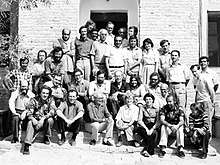
Two stories are given in the Muslim sources of how the city fell. In the first, a Persian priest proclaimed from the walls that only a dajjal was fated to capture the city. A dajjal is an Islamic term for an Al-Masih ad-Dajjal, a false messiah, compatible to the Antichrist in Christianity. In everyday use, it also means "deceiver" or "imposter". Siyah, a Persian general who had defected to Muslim side, claimed that by converting to Islam he had turned his back on Zoroastrianism and was thus a dajjal. Abu Musa agreed to Siyah's plan. Soon after as the sun came up one morning, the sentries on the walls saw a man in a Persian officer's uniform covered in blood lying on the ground before the main gate. Thinking it he had been left out overnight after a conflict the previous day, they opened the gate and some came out to collect him. As they approached, Siyah jumped up and killed them. Before the other sentries had time to react, Siyah and a small group of Muslim soldiers hidden nearby charged through the open gate. They held the gate open long enough for Muslim reinforcements to arrive and passing through the gate to take the city.[80]
In the other story, once again the Muslims were taunted from the city wall that only an Al-Masih ad-Dajjal could capture the city, and since there were none in the besieging army then they may as well give up and go home. One of the Muslim commanders was so angry and frustrated at this taunt that he went up to one of the city gates and kicked it. Instantly the chains snapped, the locks broke and it fell open.[81]
Following their entry into the city, the Muslims killed all of the Persian nobles.[81]
Once the city was taken, as Daniel (Arabic: دانيال, Danyal) was not mentioned in the Qur'an, nor is he regarded as a prophet in Judaism, the initial reaction of the Muslim was to destroy the cult by confiscating the treasure that had stored at the tomb since the time of the Achaemenids. They then broke open the silver coffin and carried off the mummified corpse, removing from the corpse a signet ring, which carried an image of a man between two lions. However, upon hearing what had happened, the caliph Umar ordered the ring to be returned and the body reburied under the river bed.[81] In time, Daniel became a Muslim cult figure and they as well as Christians began making pilgrimages to the site, despite several other places claiming to be the site of Daniel's grave.[81]
Following the capture of Susa, the Muslims moved on to besiege Gundeshapur.[80]
Susa recovered following its capture and remained a regional center of more than 400 hectares in size.[82] A mosque was built, but also Nestorian bishops are still testifie. In addition, there was a Jewish community with its own synagogue. The city continued to be a manufacturing center of luxury fabrics during this period. Archaeologically, the Islamic period is characterized mainly by its rich ceramics. Beth Huzaye (East Syrian Ecclesiastical Province) had a significant Christian population during the first millennium, and was a diocese of the Church of the East between the 5th and 13th centuries, in the metropolitan province of Beth Huzaye (Elam).
In 1218, the city was razed by invading Mongols and was never able to regain its previous importance. The city further degraded in the 15th century when the majority of its population moved to Dezful.[83]
Today
Today the ancient center of Susa is unoccupied with the population living in the adjacent modern Iranian town of Shush, which is to the west and north of the historic ruins. Shush is the administrative capital of Shush County in Iran's Khuzestan province. It had a population of 64,960 in 2005.[84] Shush is identified as Shushan, mentioned in the Book of Esther and other Biblical books.
World Heritage listing
In July 2015 it was inscribed on the list of World Heritage Sites by UNESCO.[85]
Gallery
 Letter in Greek of the Parthian king Artabanus II to the inhabitants of Susa in the 1st century CE (the city retained Greek institutions since the time of the Seleucid empire). Louvre Museum.[86]
Letter in Greek of the Parthian king Artabanus II to the inhabitants of Susa in the 1st century CE (the city retained Greek institutions since the time of the Seleucid empire). Louvre Museum.[86]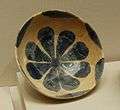 Glazed clay cup: Cup with rose petals, 8th–9th centuries
Glazed clay cup: Cup with rose petals, 8th–9th centuries Anthropoid sarcophagus
Anthropoid sarcophagus Lion on a decorative panel from Darius I the Great's palace
Lion on a decorative panel from Darius I the Great's palace%2C_late_1st_century_BC%E2%80%93early_1st_century_AD%2C_Louvre_Museum_(7462828632).jpg)
 Glazed clay vase: Vase with palmtrees, 8th–9th centuries
Glazed clay vase: Vase with palmtrees, 8th–9th centuries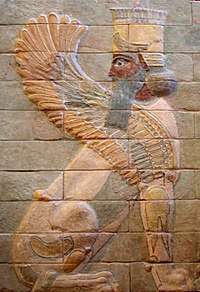 Winged sphinx from the palace of Darius the Great at Susa.
Winged sphinx from the palace of Darius the Great at Susa. Ninhursag with the spirit of the forests next to the seven-spiked cosmic tree of life. Relief from Susa.
Ninhursag with the spirit of the forests next to the seven-spiked cosmic tree of life. Relief from Susa. 19th-century engraving of Daniel's tomb in Susa, from Voyage en Perse Moderne, by Flandin and Coste.
19th-century engraving of Daniel's tomb in Susa, from Voyage en Perse Moderne, by Flandin and Coste. Archers frieze from Darius' palace at Susa. Detail of the beginning of the frieze, left. Louvre Museum
Archers frieze from Darius' palace at Susa. Detail of the beginning of the frieze, left. Louvre Museum Ribbed torc with lion heads, Achaemenid artwork, excavated by Jacques de Morgan, 1901, found in the Acropole Tomb
Ribbed torc with lion heads, Achaemenid artwork, excavated by Jacques de Morgan, 1901, found in the Acropole Tomb- Shush Castle, 2011
- Children in Susa
 Herm pillar with Hermes, from the well of the "Dungeon" in Susa.
Herm pillar with Hermes, from the well of the "Dungeon" in Susa.
See also
- Abulites
- Achaemenid architecture
- Choqa Zanbil
- Cities of the Ancient Near East
- Elam
- History of Iran
- List of oldest continuously inhabited cities
- Monsieur Chouchani
- Muslim conquest of Khuzestan
- Short chronology timeline
Notes
- Thomas A. Carlson et al., “Susa — ܫܘܫ ” in The Syriac Gazetteer last modified June 30, 2014, http://syriaca.org/place/415.
- John Curtis (2013). "Introduction". In Perrot, Jean (ed.). The Palace of Darius at Susa: The Great Royal Residence of Achaemenid Persia. I.B.Tauris. p. xvi. ISBN 9781848856219.
- Kriwaczek, Paul. Babylon: Mesopotamia and the Birth of Civilization, St. Martin's Press, 2010, p. 5
- George Rawlinson, A Memoir of Major-General Sir Henry Creswicke Rawlinson, Nabu Press, 2010, ISBN 1-178-20631-9
- Internet Archive, William K. Loftus, Travels and Researches in Chaldaea and Susiana, Travels and Researches in Chaldaea and Susiana: With an Account of Excavations at Warka, the "Erech" of Nimrod, and Shush, "Shushan the Palace" of Esther, in 1849–52, Robert Carter & Brothers, 1857
- Jane Dieulafoy, Perzië, Chaldea en Susiane. (in Dutch)
- Peters, John P. (1915). "Excavations in Persia" (PDF). The Harvard Theological Review. 8 (1): 82–93. doi:10.1017/S0017816000008336. ISSN 0017-8160. JSTOR 1507314.
- Peters, John P. (1915). "Excavations in Persia" (PDF). The Harvard Theological Review. 8 (1): 82–93. doi:10.1017/S0017816000008336. ISSN 0017-8160. JSTOR 1507314.
- Archive.org, Jacques de Morgan, Fouilles à Suse en 1897–1898 et 1898–1899, Mission archéologique en Iran, Mémoires I, 1990
- Archive.org, Jacques de Morgan, Fouilles à Suse en 1899–1902, Mission archéologique en Iran, Mémoires VII, 1905
- Robert H. Dyson, Early Work on the Acropolis at Susa. The Beginning of Prehistory in Iraq and Iran, Expedition, vol. 10, no. 4, pp. 21–34, 1968
- Roland de Mecquenem: Archives de Suse (1912–1939) – in French
- Harvard.edu Archived 11 October 2008 at the Wayback Machine Shelby White – Leon Levy Program funded project to publish early Susa archaeological results
- Roman Ghirshman, Suse au tournant du III au II millenaire avant notre ere, Arts Asiatiques, vol. 17, pp. 3–44, 1968
- Hermann Gasche, Ville Royal de Suse: vol I : La poterie elamite du deuxieme millenaire a.C, Mission archéologique en Iran, Mémoires 47, 1973
- M. Steve and Hermann H. Gasche, L'Acropole de Suse: Nouvelles fouilles (rapport preliminaire), Memoires de la Delegation archeologique en Iran, vol. 46, Geuthner, 1971
- Jean Perrot, Les fouilles de Sus en 1975, Annual Symposium on Archaeological Research in Iran 4, pp. 224–231, 1975
- D. Canal, La haute terrase de l'Acropole de Suse, Paleorient, vol. 4, pp. 169–176, 1978
- Potts: Elam, pp. 46.
- Potts: Elam.
- Hole, Frank. "A Monumental Failure: The Collapse of Susa". In Robin A. Carter and Graham Philip, eds., Beyond the Ubaid: Transformation and Integration of Late Prehistoric Societies of the Middle East, pp. 221–226, Studies in Oriental Civilization, no. 63, Chicago: Oriental Institute of the University of Chicago, 2010
- Aruz, Joan (1992). The Royal City of Susa: Ancient Near Eastern Treasures in the Louvre. New York: Abrams. p. 26.
- Aruz, Joan (1992). The Royal City of Susa: Ancient Near Eastern Treasures in the Louvre. New York: Abrams. p. 29.
- "Site officiel du musée du Louvre". cartelfr.louvre.fr.
- D. T. Potts, The Archaeology of Elam: Formation and Transformation of an Ancient Iranian State. Cambridge World Archaeology. Cambridge University Press, 2015 ISBN 1107094690 p58
- Álvarez-Mon, Javier (2020). The Art of Elam CA. 4200–525 BC. Routledge. p. 101. ISBN 978-1-000-03485-1.
- "Louvre Museum Sb 2125".
- "Site officiel du musée du Louvre, Sb 2125". cartelfr.louvre.fr.
- Cheng, Jack; Feldman, Marian (2007). Ancient Near Eastern Art in Context: Studies in Honor of Irene J. Winter by her Students. BRILL. p. 48. ISBN 978-90-474-2085-9.
- D. T. Potts, The Archaeology of Elam: Formation and Transformation of an Ancient Iranian State. Cambridge World Archaeology. Cambridge University Press, 2015 ISBN 1107094690 pp 58–61
- F. Desset, An Architectural Pattern in Late Fourth-Millennium BC Western Iran: A New Link Between Susa, Tal-I Malyan, and Godin Tepe, Iran, vol. 52, iss. 1, pp. 1–18, 2014
- Lawler, Andrew. 2003. Uruk: Spreading Fashion or Empire. Science. Volume 302, pp. 977–978
- Álvarez-Mon, Javier (2020). The Art of Elam CA. 4200–525 BC. Routledge. p. 93. ISBN 978-1-000-03485-1.
- Álvarez-Mon, Javier (2020). The Art of Elam CA. 4200–525 BC. Routledge. p. 101. ISBN 978-1-000-03485-1.
- Álvarez-Mon, Javier (2020). The Art of Elam CA. 4200–525 BC. Routledge. p. 97. ISBN 978-1-000-03485-1.
- Álvarez-Mon, Javier (2020). The Art of Elam CA. 4200–525 BC. Routledge. p. 110. ISBN 978-1-000-03485-1.
- D. T. Potts, A Companion to the Archaeology of the Ancient Near East. Volume 94 of Blackwell Companions to the Ancient World. John Wiley & Sons, 2012 ISBN 1405189886 p. 743
- Per Sumerian King List
- Translation of the Akkadian portion into French, in Mémoires. Paris: P. Geuthner. 1899. pp. 4–7.
- F. Vallat, The history of Elam, 1999 iranicaonline.org
- Aruz, Joan; Fino, Elisabetta Valtz (2001). "Ancient near Eastern Art". The Metropolitan Museum of Art Bulletin. 59 (1): 8. doi:10.2307/3269163. ISSN 0026-1521. JSTOR 3269163.
- Mikołajczak, Tytus K. (2011). "Elam and Persia. Edited by Javier Álvarez-Mon and Mark B. Garrison. Winona Lake, IN: Eisenbrauns, 2011. pp. xviii + 493. $89.50 (cloth)". Journal of Near Eastern Studies. 72 (2): 284–289. doi:10.1086/671453. ISSN 0022-2968.
- Potts: Elam, pp. 364.
- "Awan King List".
- SCHEIL, V. (1931). "Dynasties Élamites d'Awan et de Simaš". Revue d'Assyriologie et d'archéologie orientale. 28 (1): 1–46. ISSN 0373-6032. JSTOR 23283945.
- Potts: Elam, pp. 122.
- "Site officiel du musée du Louvre". cartelfr.louvre.fr.
- Marshall, John (1996). Mohenjo-Daro and the Indus Civilization: Being an Official Account of Archaeological Excavations at Mohenjo-Daro Carried Out by the Government of India Between the Years 1922 and 1927. Asian Educational Services. p. 425. ISBN 9788120611795.
- "Site officiel du musée du Louvre". cartelfr.louvre.fr.
- Marshall, John (1996). Mohenjo-Daro and the Indus Civilization: Being an Official Account of Archaeological Excavations at Mohenjo-Daro Carried Out by the Government of India Between the Years 1922 and 1927. Asian Educational Services. p. 425. ISBN 9788120611795.
- "Corpus by Asko Parpola". Mohenjodaro.
- Also, for another numbering scheme: Mahadevan, Iravatham (1987). The Indus Script. Text, Concordance And Tables Iravathan Mahadevan. Archaeological Survey of India. pp. 32–36.
- "Site officiel du musée du Louvre". cartelfr.louvre.fr.
- "Site officiel du musée du Louvre". cartelfr.louvre.fr.
- Guimet, Musée (2016). Les Cités oubliées de l'Indus: Archéologie du Pakistan (in French). FeniXX réédition numérique. pp. 354–355. ISBN 9782402052467.
- Art of the first cities : the third millennium B.C. from the Mediterranean to the Indus. p. 395.
- Nandagopal, Prabhakar (13 August 2018). Decorated Carnelian Beads from the Indus Civilization Site of Dholavira (Great Rann of Kachchha, Gujarat). Archaeopress Publishing Ltd. ISBN 978 1 78491 917 7.
- "Louvre Museum Official Website". cartelen.louvre.fr.
- Guimet, Musée (2016). Les Cités oubliées de l'Indus: Archéologie du Pakistan (in French). FeniXX réédition numérique. p. 355. ISBN 9782402052467.
- Art of the first cities : the third millennium B.C. from the Mediterranean to the Indus. p. 398.
- "Persians: Masters of Empire" ISBN 0-8094-9104-4 p. 7-8
- Tavernier, Jan. "Some Thoughts in Neo-Elamite Chronology" (PDF). p. 27.
- Kuhrt, Amélie. "Babylonia from Cyrus to Xerxes", in The Cambridge Ancient History: Vol IV — Persia, Greece and the Western Mediterranean, pp. 112–138. Ed. John Boardman. Cambridge University Press, 1982. ISBN 0-521-22804-2
- Tolini, Gauthier, Quelques éléments concernant la prise de Babylone par Cyrus, Paris. "Il est probable que des négociations s’engagèrent alors entre Cyrus et les chefs de l’armée babylonienne pour obtenir une reddition sans recourir à l’affrontement armé." p. 10 (PDF)
- The Harran Stelae H2 – A, and the Nabonidus Chronicle (Seventeenth year) show that Nabonidus had been in Babylon before 10 October 539, because he had already returned from Harran and had participated in the Akitu of Nissanu 1 [4 April], 539 BCE.
- Lendering, 2010
- "Susa: Statue of Darius". Livius.org. 1 April 2009. Retrieved 8 February 2013.
- Capdetrey, Laurent (2007). Le Pouvoir Séleucide. Rennes: Presses universitaires de Rennes. p. 252. ISBN 978-2-753505-24-7.
- Boyce, Mary; Grenet, Frantz (1 January 1991), "ON THE WESTERN EDGE OF THE IRANIAN PLATEAU: SUSA AND ELYMAIS", A History of Zoroastrianism, Zoroastrianism under Macedonian and Roman Rule, Brill, pp. 35–48, doi:10.1163/9789004293915_004, ISBN 9789004293915
- Marest-Caffey, Laure (2016). "Seleukos I's Victory Coinage of Susa Revisited: A Die Study and Commentary". American Journal of Numismatics. 28: 1–63.
- Hill, John E. (2009). Through the Jade Gate to Rome: A Study of the Silk Routes during the Later Han Dynasty, First to Second Centuries CE. Charleston: BookSurge. ISBN 978-1-4392-2134-1.
- Potts: Elam, pp. 354-409.
- Le Rider, Georges (1965). Mémoires de la Délégation archéologique en Iran XXXVIII: Suse sous les Séleucides et les Parthes. Paris. pp. 349–430.
- Rawlinson, George (2007). Parthia. New York: Cosimo. p. 310. ISBN 978-1-60206-136-1.
- Robert J. Wenke, Elymeans, Parthians, and the Evolution of Empires in Southwestern Iran, Journal of the American Oriental Society, vol. 101, no. 3, pp. 303–315, 1981
- Neusner, Jacob (1972). "Babylonian Jewry And Shapur Ii's Persecution of Christianity From 339 to 379 CE". Hebrew Union College Annual. Hebrew Union College Press. 43: 77–102.
- Harper, Prudence; Aruz, Joan; Tallon, Frangoise (1993). The Royal City of Susa: Ancient Near Eastern Treasures in the Louvre. New York: The Metropolitan Museum of Art. p. 162.
- Potts: Elam, pp. 429.
- Daryaee, Touraj (2009). "SHAPUR II". Encyclopaedia Iranica.
- Crawford, Peter (2013). The War of the Three Gods: Romans, Persians and the Rise of Islam. Barnsley: Pen & Sword Military. pp. 183–184. ISBN 978-1-84884-612-8.
- Kennedy, Hugh (2007). The Great Arab Conquests: How the Spread of Islam Changed the World We Live In. London: Weidenfeld & Nicolson. pp. 128–129. ISBN 978-0-297-84657-4.
- Amiet, Pierre (1972). Mémoires de la Délégation archéologique en Iran: Glyptique susienne des origines à l'époque des Perses achéménides: cachets, sceaux-cylindres et empreintes antiques découverts à Suse de 1913 à 1967. Paris: P. Geuthner.
- M. Streck, Clifford Edmund Bosworth (1997). Encyclopaedia of Islam, San-Sze. IX. Leiden: Brill. pp. 898–899. ISBN 9789004104228.
- "World city populations: Susa". Mongabay.com. 2 December 2008. Retrieved 8 February 2013.
- "Susa". UNESCO. 2015. Retrieved 15 April 2019.
- Epigraphy of Later Parthia, «Voprosy Epigrafiki: Sbornik statei», 7, 2013, pp. 276-284
- Jonsson, David J. (2005). The Clash of Ideologies. Xulon Press. p. 566. ISBN 978-1-59781-039-5.
Antiochus III was born in 242 BC, the son of Seleucus II, near Susa, Iran.
References
- Jean Perrot, Le Palais de Darius à Suse. Une résidence royale sur la route de Persépolis à Babylone, Paris, Paris-sorbonne.fr, 2010
- Lendering, Jona (2010). "Susa, capital of Elam". The Iranian Chamber. Retrieved 17 April 2019.
- Vallat, François (13 December 2011). "The History of Elam". The Circle of Ancient Iranian Studies (CAIS). Retrieved 17 April 2019.
- Potts, Daniel T. (1999). The archaeology of Elam: Formation and transformation of an ancient Iranian state. Cambridge: Cambridge University Press. ISBN 978-0-521-56496-0. World Archaeology Series.
Further reading
- Bosworth, C. E. (1975). The Cambridge History of Iran, Volume 3 (1): The Seleucid, Parthian and Sasanian periods. Cambridge: Cambridge University Press. ISBN 978-0-521-20093-6.
- Daryaee, Touraj (2014). Sasanian Persia: The Rise and Fall of an Empire. I.B.Tauris. ISBN 978-0857716668.
- Jalalipour, Saeid (2014). The Arab Conquest of Persia: The Khūzistān Province before and after the Muslims Triumph (PDF). Sasanika.CS1 maint: ref=harv (link)
- Westenholtz, J. G.; Guthartz, L. Taylor (1996). Royal Cities of the Biblical World. Jerusalem: Rubin Mass. ISBN 978-9657027011.</ref>
Excavation reports
Although numerous excavation reports have been published so far, many excavations are not or only partially published. Above all, the found architecture was often presented only in short preliminary reports and plans.
- Pierre Amiet: Glyptique susienne des origines à l'époque des Perses achéménides: cachets, sceaux-cylindres et empreintes antiques découverts à Suse de 1913 à 1967, Mémoires de la Délégation archéologique en Iran, Paris 1972.
- Roman Ghirshman: Cinq campagnes de fouilles a Suse (1946–1951). In: Revue d'Assyriologie et d'archéologie Orientale 46, 1952, pp 1–18.
- Florence Malbran-Labat: Les inscriptions royales de Suse: briques de l'époque paléo-élamite à l 'empire néo-élamite, Paris 1995.
- Laurianne Martinez-Sève: Les figurines de Suse. Réunion des Musées Nationaux, Paris 2002, ISBN 2-7118-4324-6.
- Jacques de Morgan, G. Jéquier, G. Lampre: Fouilles à Suse, 1897–1898 et 1898–1899. Paris 1900.
- Georges Le Rider : Suse sous les Séleucides et les Parthes: les trouvailles monétaires et l'histoire de la ville, Mémoires de la Délégation Archéologique en Iran, Paris 1965.
- Vincent Scheil: Inscriptions of Achéménides à Suse. Actes juridiques susiens, Mémoires de la Mission Archéologique de Perse, Vol. 21–24, Paris 1929–1933.
- Agnes Spycket: Les figurines de Suse, Paris 1992.
- Marie-Joseph Steve, Hermann Gasche: L'Acropole de Suse. Nouvelles fouilles (rapport préliminaire), Mémoires de la Mission Archéologique de Perse vol. 46, Leiden 1971.
External links
| Wikimedia Commons has media related to Susa. |
- ARAB II. Arab Conquest of Iran
- "Early Works on the Acropolis at Susa" Expedition Magazine 10.4 1968
- Livius.org Pictures of Susa
- Aerial views of Susa at the Oriental Institute
- Digital Images of Cuneiform Tablets from Susa – CDLI
- Hamid-Reza Hosseini, Shush at the foot of Louvre (Shush dar dāman-e Louvre), in Persian, Jadid Online, 10 March 2009.
- Audio slideshow at Jadidonline.com (6 min 31 sec)

- Susa I. Excavations
- Susa II. History During The Elamite Period
- Susa III. The Achaemenid Period
- Susa IV. The Hellenistic and Parthian Periods
- Susa V. The Sasanian Period
.jpg)
.jpg)

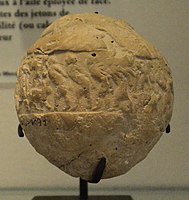


.jpg)
